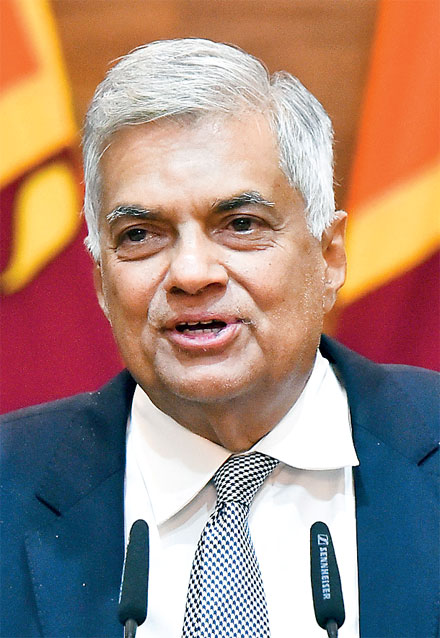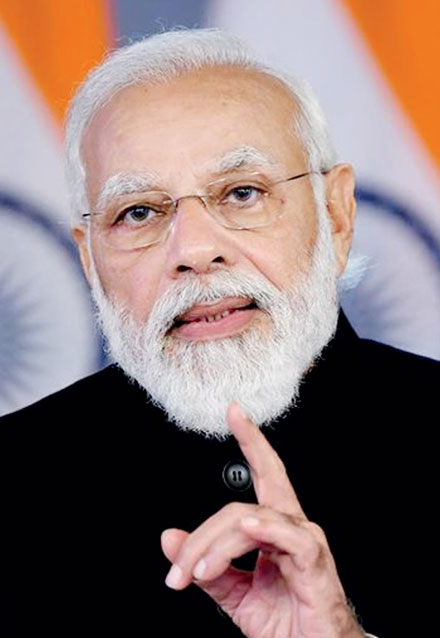Monday Apr 07, 2025
Monday Apr 07, 2025
Wednesday, 3 August 2022 00:10 - - {{hitsCtrl.values.hits}}

President Ranil Wickremesinghe

Indian Prime Minister Narendra Modi
 Sri Lanka’s pre-emptive foreign debt default in mid-April 2022 and President Gotabaya Rajapaksa’s resignation on 14 July provides India with an opportunity to match China in the foreign aid game. The Indian government held an all-party meeting on the Sri Lankan crisis on 19 July and Sri Lanka’s Parliament elected Ranil Wickremesinghe as the new President from among MPs on 20 July.
Sri Lanka’s pre-emptive foreign debt default in mid-April 2022 and President Gotabaya Rajapaksa’s resignation on 14 July provides India with an opportunity to match China in the foreign aid game. The Indian government held an all-party meeting on the Sri Lankan crisis on 19 July and Sri Lanka’s Parliament elected Ranil Wickremesinghe as the new President from among MPs on 20 July.
Sri Lanka’s crippling debt and economic crisis
The debt default and a shortage of US dollars in Sri Lanka has caused stagflation — high unemployment and little growth — in its economy. Inflation has spiralled to over 50%, leading to higher food and fuel prices. There is significant food insecurity in Sri Lanka while some 750,000 people have fallen into poverty. The economy could contract by 6-8% in 2022.
This economic crisis —Sri Lanka’s worst since gaining independence in 1948 — is due to a tepid recovery from the COVID-19 pandemic, the Russia–Ukraine conflict shock and economic policy mis-steps under Rajapaksa’s administration.
Sri Lanka faces challenges in getting foreign aid. 60% of the world’s poorest countries are also experiencing debt distress, and the prospect of a second global recession in the next three years could dampen the rest of the world’s enthusiasm to support Sri Lanka. Some perceive Sri Lanka’s economic crisis to be largely of its own making through mismanagement and corruption, and question why another country should have to bail out its economy.
India as an emerging aid donor
India was the first to respond to Sri Lanka’s desperate calls for foreign aid to tackle its crippling debt and economic crisis. India has been motivated by both the unfolding humanitarian crisis affecting the Sri Lankan people and political pressure from South India. In the first six months of 2022, Indian aid worth $ 3.8 billion has flowed to Sri Lanka through credit lines, loans and grants. This is India’s largest bilateral aid program in recent times.
Supporting Sri Lanka could be in India’s best interest. Stabilising Sri Lanka’s economy could be a major win for Indian Prime Minister Narendra Modi’s neighbourhood-first policy. Once the Sri Lankan economy stabilises, India could deepen its trade and investment linkages with Sri Lanka, transcending the current humanitarian aid relationship. This could spur regional integration and prosperity. It could also help advance India’s long-held ambition of securing a seat on the United Nations Security Council. Meanwhile, an unstable Sri Lankan economy could pose security risks to India and lead to a flood of refugees across the Palk Strait.
India could cement its first mover advantage over China by leading an aid consortium for Sri Lanka, working closely with others like the United States, Japan, the European Union, and the International Monetary Fund (IMF). Back-of-the-envelope calculations suggest that Sri Lanka will require between $ 20–25 billion over the next three years to provide essential imports of food, medicine and fuel for Sri Lankan people and to help stabilise the economy.
China’s dilemma in bailing out Sri Lanka
Despite benefitting from commercial loans for Belt and Road projects in Sri Lanka, which have fuelled a ‘debt trap’ narrative, China faces a dilemma in bailing out Sri Lanka. China worries that unilaterally restructuring Sri Lanka’s debt or giving it moratoria would set a new precedent in its lending practices and cause a queue of similarly distressed countries seeking debt relief from China. China, wanting to challenge the United States, does not want its reputation to be tarnished by bailing out a floundering economy.
Policy priorities for Sri Lanka
There are many important issues facing President Wickremesinghe’s administration.
It has to significantly improve the distribution of essentials like fuel and food to provide relief to the suffering people throughout Sri Lanka, both in urban and rural areas.
It must show it is serious about stabilising the economy by concluding talks on an IMF program that will increase taxes and utility prices to raise revenue as well as increase interest rates further to control inflation. Social welfare expenditures to protect the poor are expected to be preserved in the IMF program. One hopes that the World Bank will step up its cash transfers to the poor by re-profiling the finances of existing projects and bilateral donors will provide food aid on humanitarian grounds.
The new government will have to implement structural reforms to make the economy more market oriented. This means reducing barriers to exports and investment, cutting large amounts of red tape and sorting out loss-making state-owned enterprises. It will also have to build a national consensus on implementing the IMF program and reforms by explaining that this is the only solution to the crisis. Political reforms are essential because of the enormous public dis-trust in the political system and existing politicians. The rule of law needs to be restored and strong anti-corruption policies, including asset declarations for all parliamentarians and a strong anti-corruption office supported by the United Nations, need to be enforced. Later on, the executive presidency should also be abolished with a return to a Westminster style Parliamentary System.
The new government will also need to reset foreign policy toward a more neutral direction and away from the overly pro-China stance of Mahinda and Gotabaya Rajapaksa.
A last word
ecent events encourage pessimism about the Sri Lankan economy. But, with significant political will to tackle difficult issues and the right set of policies, strategically located Sri Lanka stands a sporting chance of achieving some economic normalcy in the next 2–3 years. India stands to gain by supporting Sri Lanka in its hour
of need.
(The writer is a Non-Resident Senior Fellow at the National University of Singapore and a Senior Research Associate at the Overseas Development Institute in London. This article updates an earlier version published in East Asia Forum of the Australian National University.)
Discover Kapruka, the leading online shopping platform in Sri Lanka, where you can conveniently send Gifts and Flowers to your loved ones for any event including Valentine ’s Day. Explore a wide range of popular Shopping Categories on Kapruka, including Toys, Groceries, Electronics, Birthday Cakes, Fruits, Chocolates, Flower Bouquets, Clothing, Watches, Lingerie, Gift Sets and Jewellery. Also if you’re interested in selling with Kapruka, Partner Central by Kapruka is the best solution to start with. Moreover, through Kapruka Global Shop, you can also enjoy the convenience of purchasing products from renowned platforms like Amazon and eBay and have them delivered to Sri Lanka.
Discover Kapruka, the leading online shopping platform in Sri Lanka, where you can conveniently send Gifts and Flowers to your loved ones for any event including Valentine ’s Day. Explore a wide range of popular Shopping Categories on Kapruka, including Toys, Groceries, Electronics, Birthday Cakes, Fruits, Chocolates, Flower Bouquets, Clothing, Watches, Lingerie, Gift Sets and Jewellery. Also if you’re interested in selling with Kapruka, Partner Central by Kapruka is the best solution to start with. Moreover, through Kapruka Global Shop, you can also enjoy the convenience of purchasing products from renowned platforms like Amazon and eBay and have them delivered to Sri Lanka.